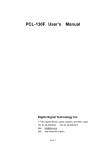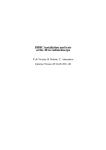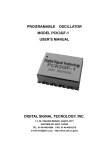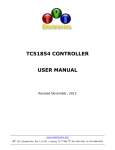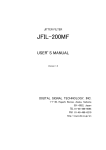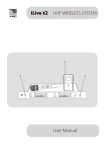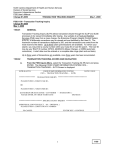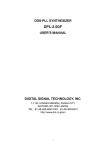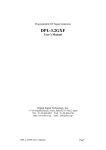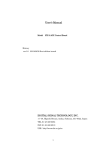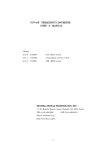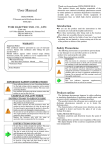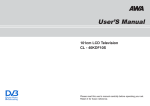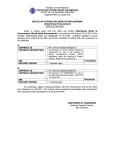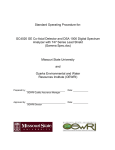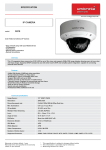Download PCL-850 CLOCK GENERATOR User` Manual
Transcript
PCL-850 CLOCK GENERATOR User’ Manual History REV1.0 10/1/2002 REV1.1 11/27/2002 issued revised Digital Signal Technology Inc. 1-7-30, Higashi Benzai, Asaka, Saitama, 351-0022, Japan TEL 81-48-468-6094 FAX 81-48-468-6210 Mail [email protected] URL http://www.dst.co.jp/en page 1 1. Functional outline As a signal source, desired clock signals can be generated with 1Hz resolution in an extremely wide band of 1MHz to 850MHz. Wideband signals up to 850MHz are generated by PLL multiplication of the signal generated by a 32-bit DDS (direct signal synthesizer). The frequency is set with asynchronous serial data. Also, the frequency can be easily set by selecting CHs saved in the incorporated 64CH memory with parallel data. 2. Specifications 2-1. Electrical specifications Power supply voltage +3.3V±5% Consumption current 250mA or less Output level LVPECL differential output (3.3V) Output frequency range 1MHz - 850MHz Frequency resolution 1Hz Output waveform duty 50%±20% Frequency accuracy ±20ppm(0 - 50℃) Jitter 1MHz - 400MHz ±30pSrms 400MHz - 850MHz ±50pSrms (Cycle to Cycle Jitter) Spurious level 1MHz - 100MHz -45dB or more 400MHz - 820MHz Frequency control Serial input -32dB or more two signal lines 9600bps, 8 bits No parity, 1 stop bit ASCII 9-digit numerical data + line feed code Memory CH selection Parallel input eight signal lines 6 bits; selection signals (64CH) 1 bit; SET signal Frequency setting time Within 5mS Time between transferring a delimiter code and obtaining the set frequency in the case of serial data. Time between giving a SET signal and obtaining the set frequency in the case of memory CH selection. Outer dimensions 40x32.5x13 (mm) page 2 2-2. Environmental conditions Operating temperature range 0℃~50℃ Storage temperature range -30℃~+70℃ 3. Outer dimensions 0.00 27.94 37.80 35.56 33.02 30.48 13.00 22.86 20.32 17.78 15.24 12.7 10.16 BOTTOM VIEW 0.00 -5.00 0.6typ (21PL) 5.08 2.54 0.00 -2.20 pin1 30.30 -2.20 4. Pin assignments GND 1 16 +3.3V 2 15 TXD GND 14 RXD D0 D1 D2 D3 D4 D5 SET GND 3 4 5 6 7 8 13 12 9 10 11 (TOP VIEW) page 3 OUT /OUT GND 5. Pin names and descriptions Pin No. Name Description 1 GND Power supply/signal GND. 2 +3.3V Power supply pin, to which +3.3V±5% should be supplied. 3 D0 Memory CH selection signal. Input of signal selection bit 0 (20). 4 D1 Memory CH selection signal. Input of signal selection bit 1 (21). 5 D2 Memory CH selection signal. Input of signal selection bit 2 (22). 6 D3 Memory CH selection signal. Input of signal selection bit 3 (23). 7 D4 Memory CH selection signal. Input of signal selection bit 4 (24). 8 D5 Memory CH selection signal. Input of signal selection bit 5 (25). 9 SET Set signal for memory CH selection. As it is pulled up (10KΩ) internally, the frequency in the memory CH selected by D0 - D5 is set by connecting it to GND. Data is loaded on the falling edge. 10 GND Power supply/signal GND. 11 GND Power supply/signal GND. 12 /OUT PECL differential output terminal. 13 OUT PECL differential output terminal. 14 RXD Asynchronous serial data input pin. The level is 3.3V CMOS. When not in use, open it. 15 GND Power supply/signal GND. 16 TXD Asynchronous serial data output pin. The level is 3.3V CMOS. When not in use, open it. page 4 6. Control by serial data How to set from a PC serial port (RS-232C) is explained below. 6-1. Communication specifications Communication speed 9600bps Data bit 8 bits Parity None Stop bit 1 bit Flow control None Level 3.3V CMOS 6-2. RS-232C connection The electric signal level of PCL-850 serial communications is 3.3V CMOS, which cannot be directly connected to a PC serial port, etc. (RS-232C level). Level conversions between RS-232C and 3.3V CMOS are made via the level converter as shown in the following figure. page 5 Note: The U2 level conversion IC is ICL3232CP manufactured by INTERSIL. The other ICL32XX series of level conversion ICs are also usable. 6-3. Command definitions Character strings enclosed in double quotation marks “ ” mean ASCII codes, and CR and LF, which are control codes, mean 0D (hex) and 0A (hex). If any invalid command is input, “INVALID DATA” LF CR “*” is returned. All characters used for input should be uppercase. If a normal command is input, “*” is returned. Also, the input data is echoed back. 6-3-1. Frequency setting command For frequency setting, inputs can be made in MHz, KHz, and Hz. (1) Setting in MHz For setting 123MHz, input the following data. “123M” CR In this case, all the data below 100KHz is set to “0.” (2) Setting in KHz For setting 123456KHz, input the following data. “123456K” CR In this case, all the data below 100Hz is set to “0.” (3) Setting in Hz For setting 123456789Hz, input the following data. “123456789” CR 6-3-2. SAVE command By inputting “SAVE” CR, the currently set frequency is saved in nonvolatile RAM. The saved frequency is output when the power is turned on again. By inputting “SAVE xxx yyy...” CR, the frequency can be saved in the specified memory CH. Here, xxx is a memory address of 64CH specified by 0 - 63 at the maximum. yyyyyy... is the frequency data explained in 6-3-1. page 6 For saving a frequency of 123MHz in memory CH address 0, input the following data. “SAVE 0 123M” CR For saving a frequency of 123456KHz in memory CH address 63, input the following data. “SAVE 63 123456K” CR 6-3-3. READ command By inputting “READ” CR, the currently saved data in all memory CHs is output. The response is as follows: “fffffffff” CR LF “00 fffffffff” CR LF “01 fffffffff” CR LF “02 fffffffff” CR LF . . . “63 fffffffff” CR LF “*” “fffffffff” on the first line is the default frequency to be output at power-on. On the second line to the 121st line frequency data is saved in the memory CHs. Here, “fffffffff” is the output frequency in each memory CH displayed in Hz. 6-4. Caution for setting data consecutively In the case of switching frequencies at high speed, data may drop out because the PCL850 does not perform flow control. Upon completion of processing by sending a frequency setting command in 6-3-1, the prompt “*” is returned; therefore, confirm the receiving of this prompt, and then send the next frequency setting command. page 7 7. Memory CH selection by parallel data It is designed so that frequency data saved in the maximum 64CH memory can be easily set by seven selection signals and one SET signal. 7-1. Example of SW connection circuit Remarks: Only the SET signal is pulled up internally. When not using D0 - D5, connect them to VCC or GND. The input data of D0 - D5 is loaded on the falling edge of SET. When not using RXD and TXD, open them. page 8 8. Shipping inspection 8-1. Electrical inspection 100% inspection shall be performed for the electrical specifications in 2-1. 8-2. Appearance inspection Inspection shall be performed for contamination and bends in pins. 9. Soldering conditions Perform soldering at a temperature of 260℃ or less within 10 seconds. 10. Warranty If any defect is found due to the manufacturer’s improper production or design within one year after delivery, repair or replacement shall be performed at the manufacturer’s responsibility. 11. Other 11-1. This product, which employs a CMOS device, may be easily damaged by static electricity. 11-2. Keep in mind that immersion cleaning is not allowed. 11-3. Special damp proof control is not necessary. ・ Descriptions in this manual are subject to change without notice. ・ No part of this manual may be reproduced without our permission. ・ We shall assume no liability for any user damage as a result of an accident, etc. ・ Descriptions in this manual shall not guarantee the practice of industrial property and other rights or grant a license for them. ・ We shall assume no liability for any third party’s industrial property rights attributable to the use of circuits, etc., described in this manual. Digital Signal Technology, Inc. page 9









